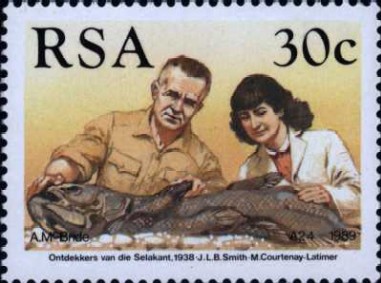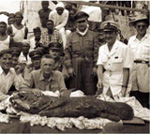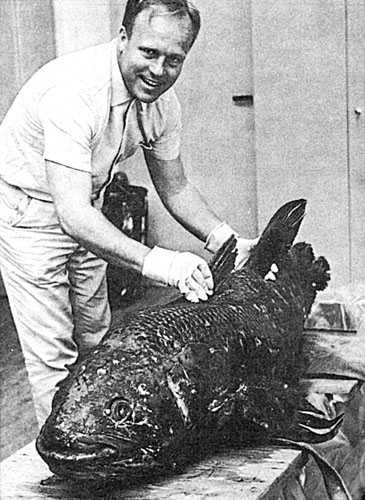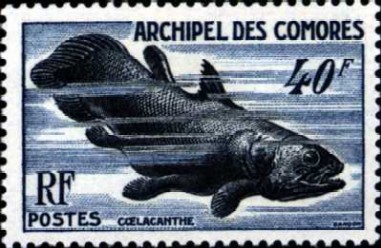Was Coelacanth Really “Discovered” in 1938?
Posted by: Loren Coleman on July 24th, 2009

Guest mini-blogger Jerome F. Hamlin, founder of Dinofish, speaking from outside of cryptozoology, shares his questions, which appear grounded in some culturally-based confusion with Cryptomundo today.

The coelacanth, one of the cornerstones of cryptozoology, falls into the special class of animals that are not rumored to exist and then confirmed by science, such as Nessie or Bigfoot might hopefully be, but that are not even thought about until they suddenly pop into our awareness. The megamouth shark or the new species of bat found in the Comoros, are other examples of this class.

But beyond this, was the coelacanth really even famously discovered in 1938 by Marjorie Courtenay-Latimer and JLB Smith? By this question, I’m not referring to possible earlier claims of discovery, but to the fact that the fish was well known by another name (Gombessa) for hundreds of years in the Comoros! Further, the Indonesian coelacanth was also previously known to Indonesian fishermen, supposedly by the name, Rajah Laut-“King of the Sea.”
So the term “discovery” in these cases is being used Eurocentrically to refer to discovery by Westerners or Western science. Only in the cases of the Sodwana, South African coelacanths- discovered by Tri mix SCUBA divers or the recent Tanzanian catches resulting from a shift in fishing techniques, has the coelacanth actually been discovered in places where it did not go by another name. These, indeed, are discoveries.
What say you?

I think Hamlin raises pretty much of a red herring, (no pun intended, regarding coelacanths, of course), as the formal definition of cryptozoology acknowledges that cryptids are regularly ethnoknown first, that’s what local and native sightings are all about, and that it is Western science that is verifying a “new species.”
But I thought I would share it here, as others may have some thoughts on this point. ~ Loren

“The coelacanth (Latimeria chalumnae) is the darling of cryptozoology, a true living fossil. Its story demonstrates that unknown, undiscovered, or at least long-thought-extinct animals can still be found – especially in the oceans.” – – from The Field Guide to Lake Monsters, Sea Serpents, and Other Mystery Denizens of the Deep .

About Loren Coleman
Loren Coleman is one of the world’s leading cryptozoologists, some say “the” leading living cryptozoologist. Certainly, he is acknowledged as the current living American researcher and writer who has most popularized cryptozoology in the late 20th and early 21st centuries.
Starting his fieldwork and investigations in 1960, after traveling and trekking extensively in pursuit of cryptozoological mysteries, Coleman began writing to share his experiences in 1969. An honorary member of Ivan T. Sanderson’s Society for the Investigation of the Unexplained in the 1970s, Coleman has been bestowed with similar honorary memberships of the North Idaho College Cryptozoology Club in 1983, and in subsequent years, that of the British Columbia Scientific Cryptozoology Club, CryptoSafari International, and other international organizations. He was also a Life Member and Benefactor of the International Society of Cryptozoology (now-defunct).
Loren Coleman’s daily blog, as a member of the Cryptomundo Team, served as an ongoing avenue of communication for the ever-growing body of cryptozoo news from 2005 through 2013. He returned as an infrequent contributor beginning Halloween week of 2015.
Coleman is the founder in 2003, and current director of the International Cryptozoology Museum in Portland, Maine.










CryptoImformant
Isnt the situation with the shark that its abilities focus on smell, and detection and managing its physical abilities, much like a robot sub and being so we are more than half way to our robot shark already and thre are robot fish. Sharky doesnt have much of a social life or mental life even though some has been reported and is finding out what the shark can do a work in progress not conclusive?
Not much been done on the possum I think and I guess it is probably comparable with the common rat. Thats quite considerable and in possum versus man in new zealand the possum appears to be holding its own.
I will be honest I do not know if a shark is more intelligent than a possum or if it is possible to make a proper comparison, but I would tend toward the possum without good evidence.
Mystery_Man
How I think it works is that there is, something inherent in the evolutionary process which on average tends to lead to greater complexity and this has happened/ is happening on this planet. In any particular at any one period this process may be fast or slow or very slow. An important driver of this process is competition between life forms and a drift to versatility. More complex life forms tend to have stored and unused potential whose DNA can be switched on and selected to deal with new conditions.
I think this process may reverse when conditions become unfavorable to life. One could speculate what has happened on Mars, assumming it had life and it now shrunk to be invisible.
Does anyone know if the Coelecanth has changed or not? Physical conditions for it have probably changed and so has the local fauna. So it has very likely it has had discreet changes not easily seen but significant, enough to enable it to survive. Without more evidence it cannot be said that it has not changed. It probably can be said it has changed but not by what degree
So we agree assessments can be made of some kind of relative value of different life forms but you insist on an entirely objective system decided by scientists. I think in the real world peoples feelings and preferences should be part of the decision and I didnt say ignore the scientists but take their contribution into account.
Also in the real world apparent contradictions can live together and do and oxymoronic utterences make sense. Being subjective and objective in the same arena can be valid and beneficial. Scientists are quite fallible you will see if you study these matters and some kind of natural wisdom outside science is needed to provide balance, starting with political science. Viz dont do what scientists say blindly and people have a right to an opinion ie be subjective if they wish.
The most amazing discovery in nature in the last century on this planet was the ubiquity of life. Perhaps billions of tons of life newly discovered miles and miles of them under our feet at every step. How many life forms was this perhaps more than ever discovered previously. Maybe in combinations we havenot dreamt of with strange capabilities. Perhaps in combination going through solid rock achieving group intelligence and affecting us in new ways.
Maybe indirectly mystery_man has reminded me of these and this and other obsevations here makes me think the subject needs a bit of a rethink ! This includes me.
Norman-UK – Two things – one, while the full picture of a Great White’s behavior is incomplete, some pieces of the puzzle have been filled in. The Great White does exhibit, in some instances, pack-hunting behavior, as well as problem-solving skills and a tendency to stalk prey much like a serial killer would.
As for your continuing assertion that life tends “on average” to move towards greater complexity, you seem to be missing the fact that more than half of all the species on this planet are things like bacteria, amoebas, dinoflagellates, algae, and other, very simple organisms. There is some debate as to whether viruses and prions count as living things but, whether or not you include these two ultra-simple groups of organisms(?), the fact remains that, on average, life does not evolve towards superfluous complexity. Indeed, natural selection seems to favor the simplest solution that will work, which is perhaps why pandas still don’t have real thumbs.
Crypto Imformant 2. 0
Does the Great white’s pack hunting include co-operative behaviour exibiting short term unselfishness for later gain? Presumably not just coincidently hitting the same targets. It is possible the description ”pack hunting” could mean a lot or a little ! I doubt the Great White is in the same league as the Killer Whale and I think we know who cares for their young best. Isnt the latter trait much admired by us anthropomorphics ?
Yep, there are a lot of relatively simple life forms about but are they getting more complex ? I think they are, at the same time are new life forms coming into being ? In addition are new life forms being seeded from space as perhaps the red rain was in India? but maybe I’m casting to wide a net here !
What is happening in the hugh new biomass discovered on this planet is surely terra incognita as yet though we have an inkling. I dont see why increasing complexity shouldnt rule here either despite setbacks when it all starts again.
You state, generally life does not evolve toward superfluous complexity. I think it probably does here and there and evolution is not an exact process and like earth, only looks smooth from a million miles away. If natural selection favours the simplest solution it doesnt mean the solution is simple, it depends on the task and circumstances and the competition. Give the Panda time, if a thumb is better, it will get it.
Yeah, those scientists are always looking through their little tunnel of “logic” that they never really see what’s out there!
If the natives knew about this for all that time, what about mokele mbembe? That crazy murderous dino living out in Africa? There’s lots of interesting critters not known to science, but the natives talk about them all the time!